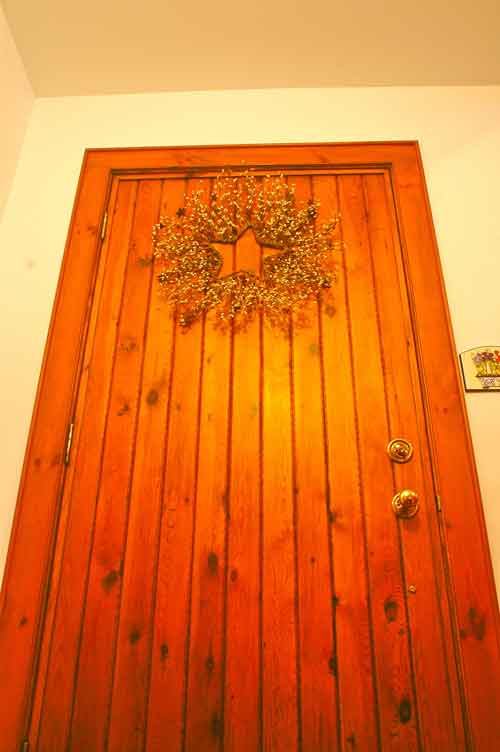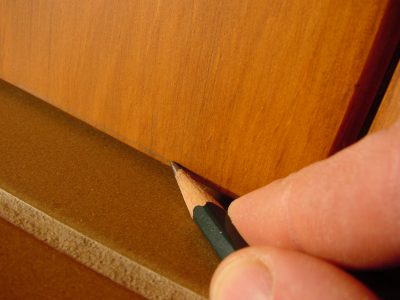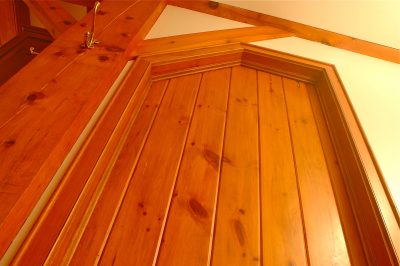 UPDATED 14AUG2018: Summer is the time of year when you’re most likely to have a sticky wooden door. Humid weather is the reason why, of course. Many consecutive days of high humidity causes the wood to absorb moisture and swell, making doors larger than they were during dry, winter months. Though you may be able to find a handyman to travel to your home and fix this minor trouble at a reasonable price, it’s not likely. The job is often just too small, and the expertise too rare. This is why it makes sense to make sticky wooden doors work well on your own whenever possible.
UPDATED 14AUG2018: Summer is the time of year when you’re most likely to have a sticky wooden door. Humid weather is the reason why, of course. Many consecutive days of high humidity causes the wood to absorb moisture and swell, making doors larger than they were during dry, winter months. Though you may be able to find a handyman to travel to your home and fix this minor trouble at a reasonable price, it’s not likely. The job is often just too small, and the expertise too rare. This is why it makes sense to make sticky wooden doors work well on your own whenever possible.
STICKY WOODEN DOOR FIX#1: LOOK FOR SIGNS OF WEAR
Start by looking at the edges and top of the door for signs of where it’s rubbing against the surrounding frame. If the door is rubbing on a hard floor along the bottom, you’ll see marks on the floor. Wherever you see evidence of rubbing, this may be where you’ll need to whittle down areas of too much wood, but maybe not. If it is, you’ll need to use a hand plane or electric power planer to get the job done. This may be something you’ve never done before, but there’s really no way around it. Always work inwards from a corner, to avoid splintering the wood if you’re working on the top or bottom of the door. The good news is that many times you don’t need to remove the door to complete planing operations. If your door rubs along the side with the handle, you may be able to plane it right there. Do you have a belt sander but no plane? A belt sander spinning an 80-grit abrasive is a pretty good tool for removing small amounts of excess wood that causes door sticking.
 If your door is rubbing along the bottom, drag a pencil along the floor to mark a line where the door needs to be cut. This is the same procedure for marking and cutting a door when floor height has been raised because new flooring was installed. To prevent splintering of the door face, place masking tape over the area of the door that will be cut, then use a jigsaw with a fine blade to remove excess wood. If there’s just a little wood to remove, once again a belt sander will work pretty well for you
If your door is rubbing along the bottom, drag a pencil along the floor to mark a line where the door needs to be cut. This is the same procedure for marking and cutting a door when floor height has been raised because new flooring was installed. To prevent splintering of the door face, place masking tape over the area of the door that will be cut, then use a jigsaw with a fine blade to remove excess wood. If there’s just a little wood to remove, once again a belt sander will work pretty well for you
All this said about doors that are too big, there may be a simpler fix since the door might not be too big at all even if it’s rubbing. It could be that the hinges have sagged because they need tightening. Get help from someone on the handle side of the door. Have them lift up on this side of the door while it’s open and while you’re looking at the hinges and feeling them with your fingers. Do the hinges move within the wooden frame? If so, it can let the door sag and cause binding against the frame or the floor. Have your helper hold up the door to take the weight, then tighten the hinge screws in the door and the frame. If the screws won’t tighten because the holes have stripped out, take out one screw, shove some toothpicks in the hole (broken off flush with the underlying wood), then drive the screw again into the partially-filled hole. Repeat the process until all untightenable screws are tight.
STICKY WOODEN DOOR FIX#2: CONSIDER RISING BUTT HINGES
If your door binds with the floor only as it opens – perhaps against a carpet or broadloom – consider something called rising butt hinges. They automatically lift the door a bit as it swings open, eliminating the need to create a large gap underneath the door just to clear carpet of a high spot. Rising butt hinges aren’t easy to find, and they’re not cheap, but they do work well. Google “rising butt hinges” for various suppliers.
STICKY WOODEN DOOR FIX#3: OILING & LATCH ADJUSTMENTS
Squeaky hinges are easy to fix. Drip light oil on swiveling parts, then open and close the door to work it in. Wipe excess oil off with a rag and they’ll continue to operate smoothly for a year or more on a single oiling.
Do you have a door that fails to latch shut reliably when you close it? Look closely around the gap around the frame where the latch is, to see exactly what’s holding the latch back. If the misalignment is small (and it usually is), a round file can solve the problem quickly. The working face of modern strike plates can also be adjusted with a flat screwdriver, used as a lever to bend the metal and tweak the latch engagement point so the door clicks shut nicely. Look for a small slot near the working surface of the latch. This is where the screwdriver goes for adjustment.
ONE MORE DOOR TIP . . .
 Do you have a door that swings open on its own? That’s a sign that the hinges aren’t in vertical alignment. If hinge pins can be removed (not all types can), have someone hold the door open, then tap the pins up and out using a large nail and gentle hammer blows. Place the hinge pins on a flat rock or concrete floor, then hit the pin in the middle with a hammer to put a slight bend in it. Reinstall pins and the added friction may keep the door where it’s put. If not, the fix involves relocating the hinges into vertical alignment using a 48-inch carpenters level for reference. That’s pretty complicated, and most people need to pass this over the someone experienced.
Do you have a door that swings open on its own? That’s a sign that the hinges aren’t in vertical alignment. If hinge pins can be removed (not all types can), have someone hold the door open, then tap the pins up and out using a large nail and gentle hammer blows. Place the hinge pins on a flat rock or concrete floor, then hit the pin in the middle with a hammer to put a slight bend in it. Reinstall pins and the added friction may keep the door where it’s put. If not, the fix involves relocating the hinges into vertical alignment using a 48-inch carpenters level for reference. That’s pretty complicated, and most people need to pass this over the someone experienced.
Need some specific advice? Send me an email at [email protected]